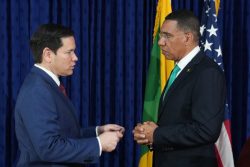By Jorge Chabat
MEXICO – Drug trafficking has existed in Mexico for decades. But trade in illegal narcotics did not seriously threaten Mexico’s stability or provoke conflict with the United States until the mid-1980’s, when Colombian cocaine began to flood across Mexico to the US. By that time, Mexican police institutions were in a state of decomposition, making them fertile ground for the drug traffickers to corrupt. And so they have.
The dismantling of Colombia’s Cali and Medellin cartels in the 1990’s created a vacuum that Mexico’s cartels were able to fill, ultimately consolidating their position in the drug trade. Still, the levels of drug-related violence in Mexico remained relatively low.
This “dealers’ peace” can be explained by the Mexican government’s policy of tolerance, which sought a degree of equilibrium between the drug cartels and the state in terms of trafficking routes and the territories that the cartels infiltrated.
This secret truce was maintained even after Mexico’s first open democratic presidential election in 2000, when the long-ruling Institutional Revolutionary Party was ousted from power. Then former President Vicente Fox ordered a crackdown. As drug lords were arrested, the equilibrium between gangs was destroyed, paving the way to a war between the Sinaloa and Gulf cartels – the two largest – which has generated enormous violence, as well as sharp US protests because of the impact of the fighting along the border.
When President Felipe Calderón took office in 2006, he inherited rising violence, with drug traffickers controlling parts of the country. He responded by quickly launching a frontal assault on the cartels, with the support of the army.
Calderón’s offensive increased his popularity, but it also provoked a new rise in violence, as the drug gangs not only battled government forces, but also settled accounts among themselves. The US government complained again, but at the same time the Bush administration delivered a $1.4 billion aid package, the so-called “Merida Initiative,” to fight the traffickers.
In 2008, Mexico’s government decided to attack the drug cartels’ operational nerve centers. But this only accelerated the gangs’ fragmentation, provoking a new and extraordinary increase in violence. Indeed, over 5,000 people were killed by organized drug criminals last year, more than double the death toll in 2007.
The violence has also become crueler. Since 2007, many of the cartels’ victims have been decapitated – a tactic clearly aimed at intimidating their enemies. And, as the grotesqueness of the violence has grown, so has pressure for a more effective strategy. Some critics of Calderón’s government now say that it is time to change strategy, perhaps even returning to the pre-Fox policy of tolerance.
Nevertheless, public-opinion polls still show broad backing for Calderón’s strategy. But the question is how long this support will last. The government insists that drug-related violence is concentrated in just three of the country’s 32 states, but the problem has spread to most of the country.
Of course, most victims are traffickers. But the country’s rampant violence has created an environment of insecurity that complicates everyday life for many Mexicans. Ultimately, this may turn public opinion against Calderón’s policy – a development that some drug trafficking groups are encouraging with anonymous posters, and by sponsoring popular protests in northern Mexico that demand the army’s return to its barracks.
But, at least in the short term, there seems to be no alternative to Calderón’s strategy. After all, while his policy of confrontation has generated high levels of violence, tolerance of the drug cartels corrupted state institutions, sowing the ground for the problem in the first place.
So it seems that the government’s only option is to continue the war, hoping that its longer-term effort to strengthen state institutions’ capacity and integrity will eventually prove effective. But corruption remains a profound and persistent threat to this effort, and if the government cannot reduce it significantly – especially among its anti-drug forces – a return to tolerance is inevitable.
Copyright: Project Syndicate, 2009.
www.project-syndicate.org








